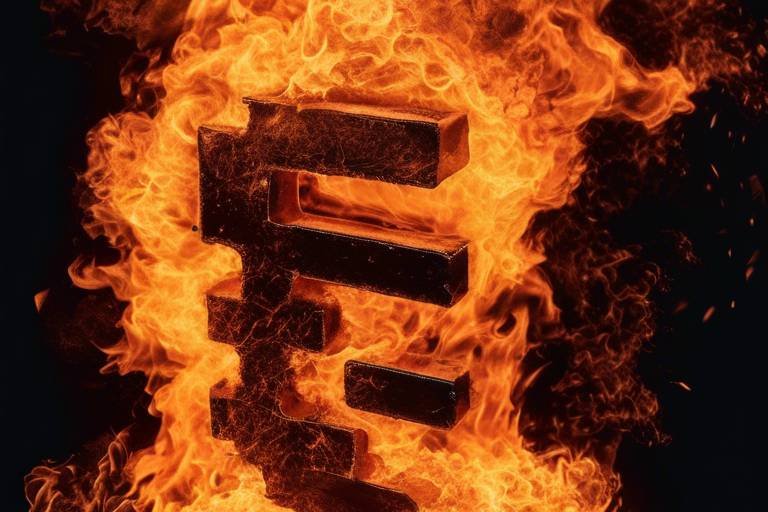How to Use Technical Analysis in Crypto Trading
In the fast-paced world of cryptocurrency trading, understanding how to use technical analysis can be a game changer. Imagine trying to navigate a stormy sea without a compass; that’s what trading without technical analysis feels like. This article aims to equip you with the essential techniques and tools of technical analysis, providing insights for traders looking to enhance their strategies in the volatile world of cryptocurrency markets. By the end of this guide, you’ll not only grasp the fundamental concepts but also feel confident in applying them to your trading endeavors.
At its core, technical analysis involves evaluating price movements and trading volumes to forecast future market behavior. Unlike fundamental analysis, which focuses on the underlying value of an asset, technical analysis zeroes in on the price action itself. It’s like reading the pulse of the market. By examining past price movements, traders can identify patterns and trends that may indicate where the market is headed next. In the realm of cryptocurrency, where prices can swing wildly, having a solid grasp of technical analysis can help you make informed trading decisions and potentially boost your profits.
When it comes to technical analysis, certain indicators are crucial for crypto traders. These indicators serve as tools to help you interpret market data and make better decisions. Some of the most effective indicators include:
- Moving Averages
- Relative Strength Index (RSI)
Understanding how to read these indicators can significantly improve your trading strategies. In the following sections, we’ll dive deeper into these key indicators, breaking them down so you can leverage them effectively in your trading.
Moving averages are essential for smoothing out price data, allowing traders to identify trends over specific time frames. Think of them as a way to filter out the noise of daily price fluctuations. There are different types of moving averages, each with its own significance in crypto trading strategies. The two most common types are:
The Simple Moving Average (SMA) is calculated by taking the average of a set of prices over a specified period. For instance, a 10-day SMA averages the closing prices of the last ten days. This gives traders a clear view of the price trend, helping them to make more informed decisions. The beauty of the SMA lies in its simplicity, but it’s essential to remember that it may lag behind the current price action, especially in volatile markets.
On the other hand, the Exponential Moving Average (EMA) gives more weight to recent prices, making it more responsive to new information. This can be particularly advantageous in the fast-moving world of cryptocurrencies. Traders often prefer the EMA for its ability to react quickly to price changes, thereby providing a more timely signal for buying or selling. By using both the SMA and EMA, traders can create a more comprehensive trading strategy that balances the benefits of both indicators.
The Relative Strength Index (RSI) is a momentum oscillator that measures the speed and change of price movements. Ranging from 0 to 100, the RSI helps traders identify overbought or oversold conditions in a market. Typically, an RSI above 70 indicates that an asset may be overbought, while an RSI below 30 suggests it may be oversold. By understanding these signals, traders can make more strategic decisions about when to enter or exit a trade, akin to catching the perfect wave at the beach.
Recognizing chart patterns can significantly enhance your trading strategies. Patterns such as head and shoulders, triangles, and flags can provide valuable insights into potential price movements. For instance, the head and shoulders pattern often indicates a trend reversal, while triangle patterns can signal potential breakout points. Familiarizing yourself with these patterns can empower you to make smarter trades and seize opportunities as they arise.
The head and shoulders pattern is one of the most reliable indicators of a trend reversal. To identify this pattern, look for three peaks: the first (left shoulder), the highest (head), and the last (right shoulder). Recognizing this formation can help you predict a shift in market sentiment, allowing you to position yourself advantageously.
Triangle patterns, which can be ascending, descending, or symmetrical, indicate periods of consolidation before a breakout. Understanding these patterns can help traders anticipate potential price movements, making it easier to capitalize on market shifts. For example, an ascending triangle often suggests that buyers are gaining strength, signaling a potential upward breakout.
Effective risk management is crucial in trading, especially in the unpredictable world of cryptocurrencies. Without a solid risk management strategy, even the best technical analysis can lead to significant losses. Here are some essential strategies to consider:
Stop-loss orders are a trader's best friend when it comes to limiting potential losses. By automatically selling assets at predetermined prices, stop-loss orders help you maintain discipline in your trading strategy. Setting these orders strategically can protect your capital and minimize emotional decision-making.
Diversifying your investments across various cryptocurrencies can significantly mitigate risks. By spreading your investments, you reduce the impact of a poor-performing asset on your overall portfolio. This approach is akin to not putting all your eggs in one basket, ensuring that your trading strategy remains robust even in turbulent market conditions.
1. What is technical analysis in crypto trading?
Technical analysis involves evaluating price movements and trading volumes to forecast future market behavior, focusing on price action rather than underlying asset value.
2. How do I use moving averages in my trading strategy?
Moving averages help identify trends by smoothing out price data. Traders often use both SMA and EMA to create a balanced strategy that reacts to market changes.
3. What are the best indicators for crypto trading?
Some of the best indicators include Moving Averages, RSI, and various chart patterns. Each offers unique insights into market behavior and can enhance trading decisions.

Understanding Technical Analysis
When you dive into the world of cryptocurrency trading, one of the most essential tools at your disposal is technical analysis. But what exactly does that mean? In simple terms, technical analysis is the art and science of evaluating price movements and trading volumes to predict future market behavior. Imagine you're trying to forecast the weather; you wouldn't just look outside and guess, right? You'd check the data, analyze trends, and make an informed decision. Similarly, technical analysis allows traders to make educated guesses about where the market is headed.
At its core, technical analysis is based on the belief that all relevant information about a cryptocurrency is already reflected in its price. This means that instead of focusing on the underlying fundamentals of a coin, technical analysts look at historical price data and trading volumes. They use this information to identify patterns and trends that can help predict future price movements. It's like trying to find a hidden treasure map in a sea of data; the right tools and techniques can lead you to your prize.
One of the key principles of technical analysis is that markets move in trends. These trends can be upward, downward, or sideways, and recognizing them is crucial for traders. Think of it as riding a wave; if you can catch the right trend, you can ride it to potential profits. However, if you misjudge the direction, you might wipe out. This is why understanding the different types of trends and how they manifest in the crypto market is vital.
Additionally, technical analysis relies heavily on various indicators and chart patterns. Indicators like Moving Averages and the Relative Strength Index (RSI) serve as valuable tools to help traders make sense of price movements. By interpreting these indicators, traders can gain insights into market momentum, overbought or oversold conditions, and potential reversal points. It's like having a compass in the wilderness; these indicators guide you through the unpredictable landscape of crypto trading.
Moreover, chart patterns play a significant role in technical analysis. Recognizing patterns such as head and shoulders or triangles can signal potential breakout points or trend reversals. These patterns are like visual clues that can help traders anticipate market movements. For instance, a head and shoulders pattern often indicates a reversal from bullish to bearish, while triangle patterns can signal a breakout, either upwards or downwards. Understanding these patterns can give traders a significant edge in their decision-making process.
In summary, technical analysis is a powerful methodology that combines data evaluation, trend recognition, and pattern identification to enhance trading strategies. By mastering these techniques, traders can navigate the volatile waters of cryptocurrency markets with greater confidence and precision. Remember, while technical analysis is a valuable tool, it's essential to pair it with sound risk management practices to safeguard your investments.

Key Indicators in Crypto Trading
When it comes to navigating the wild waters of cryptocurrency trading, having the right tools in your arsenal can make all the difference. One of the most crucial aspects of this journey is understanding key indicators. These indicators serve as your compass, guiding you through the volatility and unpredictability of the market. By analyzing price movements and trading volumes, you can develop a clearer picture of where the market might be heading. Let's dive into some of the most effective indicators that every crypto trader should know!
Among the plethora of indicators available, two stand out as particularly powerful: Moving Averages and the Relative Strength Index (RSI). Each of these indicators offers unique insights into market trends and momentum, allowing traders to make informed decisions.
Moving Averages are like the soothing balm to the chaotic price fluctuations in the crypto market. They help smooth out price data over a specified period, making it easier to identify trends. There are two main types of Moving Averages that traders commonly use: the Simple Moving Average (SMA) and the Exponential Moving Average (EMA).
The Simple Moving Average is calculated by taking the average of a set number of prices over a specific time frame. For instance, if you were to calculate a 10-day SMA, you would sum up the closing prices of the last 10 days and divide by 10. This straightforward approach allows traders to see the general direction of the market. However, it may lag behind current price movements, which is where the EMA comes into play.
The Exponential Moving Average gives more weight to recent prices, making it more responsive to new information. This characteristic can be particularly advantageous in the fast-paced world of crypto trading, where prices can change in an instant. By using the EMA, traders can identify trends more quickly, allowing for timely entry and exit points in trades.
The Relative Strength Index (RSI) is another powerful tool that traders use to gauge market momentum. It operates on a scale of 0 to 100, where readings above 70 indicate that an asset may be overbought, and readings below 30 suggest it may be oversold. This information can be crucial for making trading decisions, as it helps traders identify potential reversals in price trends.
Understanding how to interpret the RSI can significantly enhance your trading strategy. For example, if the RSI is above 70, it might be a good time to consider selling, while an RSI below 30 could signal a buying opportunity. However, it's essential to combine the RSI with other indicators to confirm your trading signals.
In summary, mastering these key indicators—Moving Averages and the RSI—can provide a solid foundation for your crypto trading strategy. By understanding how to interpret these tools, you can make more informed decisions, ultimately enhancing your chances of success in the unpredictable world of cryptocurrency.
- What is the best indicator for crypto trading? While there isn't a one-size-fits-all answer, many traders find a combination of Moving Averages and RSI to be particularly effective.
- How often should I check these indicators? It's advisable to monitor your indicators regularly, but the frequency can depend on your trading strategy—day traders may check them multiple times a day, while long-term investors may look at them less frequently.
- Can I rely solely on technical indicators for trading? While technical indicators are valuable tools, they should be used in conjunction with fundamental analysis and market news for the best results.

Moving Averages
Moving averages are a fundamental tool in the arsenal of any crypto trader. They serve as a way to smooth out price fluctuations and help identify the underlying trend of an asset. Imagine trying to navigate through a dense fog; moving averages act like a lighthouse, guiding you through the uncertainty of volatile markets. By averaging price data over a specific period, traders can gain insights into whether an asset is trending upwards, downwards, or moving sideways.
There are two primary types of moving averages that traders commonly utilize: the Simple Moving Average (SMA) and the Exponential Moving Average (EMA). Each has its unique characteristics and applications in trading strategies. The SMA is calculated by taking the average price of an asset over a specified number of periods, while the EMA gives more weight to recent prices, making it more responsive to new information. This responsiveness can be crucial in the fast-paced world of cryptocurrency, where market sentiment can shift rapidly.
To better understand how moving averages can be applied in crypto trading, let's take a look at a basic comparison of the two types:
| Type | Calculation Method | Responsiveness | Best Used For |
|---|---|---|---|
| Simple Moving Average (SMA) | Average price over a set period | Less responsive | Identifying long-term trends |
| Exponential Moving Average (EMA) | Weighted average giving more importance to recent prices | More responsive | Capturing short-term price movements |
When implementing moving averages in your trading strategy, it's essential to choose the right time frame. Shorter time frames, like the 10-day or 20-day moving averages, can provide insights into short-term trends and are often used for day trading. On the other hand, longer time frames, such as the 50-day or 200-day moving averages, are better suited for identifying long-term trends. By combining these different time frames, traders can create a more comprehensive view of the market.
Additionally, traders often look for crossovers between different moving averages as potential buy or sell signals. For instance, a bullish signal occurs when a shorter-term moving average crosses above a longer-term moving average, indicating a potential upward trend. Conversely, a bearish signal happens when the shorter-term moving average crosses below the longer-term moving average, suggesting a downward trend. These crossovers can act as critical decision points in a trader's strategy.
In summary, moving averages are not just numbers on a chart; they are powerful indicators that can guide your trading decisions. By understanding their calculation, application, and the significance of different time frames, you can harness their potential to navigate the often turbulent waters of crypto trading more effectively. Remember, the key to success lies in combining moving averages with other technical analysis tools and maintaining a disciplined approach to trading.
- What is the main purpose of using moving averages in crypto trading?
Moving averages help traders identify trends and smooth out price fluctuations, making it easier to make informed trading decisions. - How do I choose the right moving average for my trading strategy?
Consider your trading style and objectives. Shorter moving averages are better for short-term trading, while longer moving averages are suited for long-term strategies. - Can moving averages guarantee profitable trades?
No, while they are valuable tools, moving averages should be used in conjunction with other indicators and risk management strategies for better results.

Simple Moving Average (SMA)
The is one of the most fundamental tools in the arsenal of a crypto trader. Think of it as a way to smooth out the noise of price fluctuations, allowing you to see the overall trend more clearly. By averaging the prices over a specified period, the SMA provides a clearer picture of where the market is heading. For instance, if you're looking at a 10-day SMA, it takes the closing prices of the last ten days, adds them up, and divides by ten. This calculation helps traders identify whether the price is moving upward, downward, or sideways.
One of the key advantages of the SMA is its simplicity. Even if you’re just starting out in crypto trading, you can easily calculate and interpret it. However, it’s essential to understand that while the SMA can indicate trends, it may lag behind the market price because it is based on past data. This lag can sometimes lead to missed opportunities or delayed reactions to price changes. Therefore, traders often combine the SMA with other indicators for a more comprehensive analysis.
To illustrate how the SMA works, consider the following example:
| Day | Closing Price |
|---|---|
| 1 | $100 |
| 2 | $105 |
| 3 | $102 |
| 4 | $107 |
| 5 | $110 |
| 6 | $108 |
| 7 | $112 |
| 8 | $115 |
| 9 | $117 |
| 10 | $120 |
In this table, if we want to calculate the 5-day SMA on Day 10, we would take the closing prices from Day 6 to Day 10:
- $108
- $112
- $115
- $117
- $120
Adding these prices together gives us $672. Dividing by 5, the 5-day SMA for Day 10 would be $134.4. By observing how the SMA moves in relation to the actual price, traders can make informed decisions about buying or selling assets.
In summary, while the Simple Moving Average is a basic tool, its effectiveness in identifying trends cannot be overstated. It's like a compass in the vast ocean of crypto trading, helping you navigate through the turbulent waters of price fluctuations. However, always remember to use it in conjunction with other indicators to enhance your trading strategy and minimize risks.
What is the main purpose of using the SMA in crypto trading?
The main purpose of using the SMA is to identify the direction of the trend over a specific period, helping traders make informed decisions about buying or selling cryptocurrencies.
How does the SMA differ from other moving averages?
The SMA calculates the average price over a set period without giving more weight to recent prices, unlike the Exponential Moving Average (EMA), which prioritizes the most recent data.
Can I use the SMA for day trading?
Yes, many day traders use the SMA to identify short-term trends. However, it’s essential to combine it with other indicators for better accuracy.

Exponential Moving Average (EMA)
The is a powerful tool in the arsenal of any crypto trader. Unlike the Simple Moving Average (SMA), which treats all price points equally, the EMA gives more weight to recent prices. This characteristic makes the EMA particularly responsive to new information, allowing traders to react more swiftly to price changes. Imagine the EMA as a friend who always keeps you updated on the latest gossip—it's quick to tell you what's happening right now, rather than dwelling on the past.
To calculate the EMA, you first need to determine the multiplier, which is based on the chosen period. The formula for the multiplier is:
Multiplier (2 / (N + 1))
Where N is the number of periods you want to consider. For example, if you're looking at a 10-day EMA, the multiplier would be:
Multiplier (2 / (10 + 1)) 0.1818
Once you have the multiplier, the EMA can be calculated using the following formula:
EMA (Current Price - Previous EMA) * Multiplier + Previous EMA
This calculation allows the EMA to adjust more quickly to recent price movements, making it a favorite among traders who want to capitalize on short-term trends. The EMA is often used in conjunction with other indicators, such as the Relative Strength Index (RSI) or Moving Average Convergence Divergence (MACD), to provide a more comprehensive view of the market.
One of the significant advantages of using the EMA is its ability to signal potential buy and sell opportunities. For instance, when the price crosses above the EMA, it can indicate a bullish trend, suggesting it might be a good time to buy. Conversely, if the price drops below the EMA, it could signal a bearish trend, indicating a potential sell opportunity. This dynamic nature makes the EMA an essential part of many traders' strategies.
However, it's important to remember that no indicator is foolproof. While the EMA can provide valuable insights, it should be used in conjunction with other tools and strategies. Here are a few tips for effectively using the EMA in your trading:
- Combine with Other Indicators: Use the EMA alongside other technical indicators to confirm trends and signals.
- Choose Your Period Wisely: The period you choose for your EMA can significantly affect its sensitivity. Shorter EMAs react faster to price changes, while longer EMAs provide a smoother view of the trend.
- Stay Updated: Keep an eye on market news and events that could impact prices, as these can lead to sudden movements that the EMA might not catch immediately.
In conclusion, the Exponential Moving Average is a crucial component of technical analysis in crypto trading. Its ability to respond quickly to price changes makes it an invaluable tool for traders looking to navigate the often volatile crypto markets. By understanding how to calculate and interpret the EMA, you can enhance your trading strategies and make more informed decisions.

Relative Strength Index (RSI)
The is a powerful momentum oscillator that traders often use to gauge the speed and change of price movements in the cryptocurrency market. Essentially, it helps traders identify whether a cryptocurrency is overbought or oversold, which can be crucial for making informed trading decisions. The RSI operates on a scale from 0 to 100, with levels above 70 typically indicating that an asset may be overbought, while levels below 30 suggest it could be oversold. This duality makes the RSI an invaluable tool for traders looking to capitalize on market fluctuations.
To calculate the RSI, you start by measuring the average gains and losses over a specified period, usually 14 days. The formula can seem a bit complex at first, but breaking it down into steps makes it manageable:
RSI 100 - (100 / (1 + RS)) Where: RS Average Gain / Average Loss
Understanding the RSI is not just about crunching numbers; it's about interpreting what those numbers mean for your trading strategy. For instance, if the RSI crosses above the 70 mark, it could be a signal to sell, as the asset might be overvalued. Conversely, if it dips below 30, it might be time to consider buying, as the asset could be undervalued. However, traders should exercise caution and not rely solely on the RSI; it's best used in conjunction with other indicators and analysis techniques.
Moreover, the RSI can exhibit certain patterns that traders should be aware of. For instance, divergences between the RSI and the price action can indicate potential reversals. If the price is making new highs while the RSI fails to follow suit, this could suggest weakening momentum, signaling a possible trend reversal. Similarly, if the price is making new lows but the RSI is moving higher, it might indicate that the selling pressure is easing, hinting at a potential upward reversal.
In summary, the RSI is a versatile and robust tool in the arsenal of crypto traders. By understanding how to read and interpret the RSI, you can enhance your trading strategy significantly. Just remember, like any tool, it’s most effective when used alongside other indicators and market analysis techniques.
- What is the best period for calculating RSI? While 14 days is commonly used, traders may adjust the period based on their trading style and the volatility of the cryptocurrency.
- Can RSI be used in all markets? Yes, the RSI can be applied to any financial market, including stocks, forex, and commodities, but it’s particularly popular in the volatile crypto space.
- How often should I check the RSI? It depends on your trading strategy. Day traders might check it multiple times a day, while long-term investors may look at it weekly or monthly.

Chart Patterns to Watch
When navigating the tumultuous waters of cryptocurrency trading, recognizing chart patterns can be your compass. Chart patterns serve as visual representations of market psychology and can provide crucial insights into potential price movements. Whether you’re a seasoned trader or just dipping your toes into the crypto ocean, understanding these patterns can significantly enhance your trading strategies. Just like a seasoned sailor knows how to read the wind, a savvy trader knows how to read the charts.
Among the myriad of patterns that traders encounter, some stand out for their reliability and predictability. Let’s dive into a couple of the most common and impactful patterns that every crypto trader should keep an eye on:
The head and shoulders pattern is one of the most recognized indicators of a potential trend reversal. Picture a person standing with their head held high between two shoulders; this pattern forms after a bullish trend and signals that the tide may be turning. To identify this pattern, look for three peaks: the first shoulder, a higher peak (the head), and a second shoulder that is lower than the head but similar in height to the first shoulder.
Here’s how to spot this pattern:
- First, ensure that the price is in an uptrend.
- Look for the left shoulder, followed by a higher peak (the head).
- Finally, watch for the right shoulder to form, which should be lower than the head.
Once you identify this pattern, it’s crucial to watch for the breakout point, which typically occurs when the price falls below the neckline formed by the lows of the shoulders. This breakout can signal a potential sell opportunity, making it a valuable tool for traders looking to maximize their profits.
Triangles are another powerful chart pattern that can indicate potential breakout points in the market. They come in three main varieties: ascending triangles, descending triangles, and symmetrical triangles. Each type conveys different market sentiments and can lead to significant price movements.
In an ascending triangle, the price action forms higher lows while maintaining a consistent resistance level, suggesting that buyers are gaining strength. Conversely, a descending triangle features lower highs and a consistent support level, indicating that sellers may be taking control. Lastly, a symmetrical triangle occurs when the price action converges, with both higher lows and lower highs, reflecting indecision in the market.
To capitalize on these patterns, traders should wait for a breakout above resistance in ascending triangles or below support in descending triangles. The price movement following the breakout can often lead to substantial gains, making these patterns essential for any trader's toolkit.
Understanding and recognizing these chart patterns can provide traders with a significant edge in the highly volatile cryptocurrency market. By honing your skills in identifying these formations, you can better anticipate market movements and make informed trading decisions.
Q: What is the significance of chart patterns in crypto trading?
A: Chart patterns help traders identify potential price movements and market sentiments, allowing for more informed trading decisions.
Q: How can I improve my ability to recognize chart patterns?
A: Practice is key! Use demo trading accounts, study historical charts, and familiarize yourself with different patterns to enhance your recognition skills.
Q: Are all chart patterns reliable?
A: While many chart patterns have proven to be reliable indicators, no pattern is foolproof. It's essential to combine pattern analysis with other technical indicators for better accuracy.

Head and Shoulders
The pattern is one of the most recognized and reliable indicators in technical analysis, particularly in the volatile world of cryptocurrency trading. This pattern typically signals a potential trend reversal, making it a crucial tool for traders looking to capitalize on market shifts. But what exactly is this pattern, and how can you identify it? Let's break it down.
The head and shoulders pattern consists of three peaks: the left shoulder, the head, and the right shoulder. The left shoulder is formed when the price rises to a peak and then declines. Next, the price rises again to form the head, which is the highest peak of the three, followed by another decline. Finally, the right shoulder forms when the price rises once more, but this time it fails to reach the height of the head before declining again. This sequence creates a distinct shape that resembles a person’s head and shoulders, hence the name.
Identifying this pattern can be a game-changer for traders. Here’s how to spot it:
- Left Shoulder: Look for an initial price increase followed by a decline.
- Head: Watch for a higher peak followed by another decline.
- Right Shoulder: Identify a final peak that is lower than the head before the price declines again.
Once you recognize the head and shoulders pattern, it’s essential to understand its implications. The pattern typically indicates that the bullish trend is losing momentum and that a bearish trend may soon follow. This can provide traders with a valuable opportunity to enter short positions or exit long ones before significant losses occur.
It's important to note that while the head and shoulders pattern is a strong indicator, no single pattern should dictate your trading decisions. Always consider other factors and indicators in conjunction with this pattern. Additionally, traders often look for confirmation through volume. A decrease in volume during the formation of the right shoulder, followed by an increase in volume when the price breaks below the neckline, can further validate the pattern.
To illustrate this concept, consider the following table that outlines the key components of the head and shoulders pattern:
| Component | Description |
|---|---|
| Left Shoulder | Initial peak followed by a price decline. |
| Head | Highest peak followed by another decline. |
| Right Shoulder | Final peak lower than the head followed by a decline. |
| Neckline | Line connecting the lows of the two declines. |
In summary, understanding the head and shoulders pattern can significantly enhance your trading strategy. By effectively identifying this pattern and utilizing it alongside other technical indicators, you can make more informed decisions in the crypto market. Remember, trading is as much about managing risk as it is about seizing opportunities. So, keep your eyes peeled for those shoulders and heads!

Triangles
In the fast-paced world of cryptocurrency trading, recognizing triangle patterns can be a game-changer for your trading strategy. Triangles are a type of chart pattern that indicate a period of consolidation before a potential breakout, and they come in three primary forms: ascending, descending, and symmetrical. Each type of triangle has unique characteristics and implications for price movements, making them essential tools for traders looking to forecast market behavior.
Let's break down each type of triangle to understand how they can help you maximize your trading profits:
- Ascending Triangle: This pattern is characterized by a horizontal resistance line at the top and an upward-sloping support line at the bottom. It suggests that buyers are becoming increasingly aggressive, leading to a potential breakout above the resistance level. Traders often view this as a bullish signal, indicating that the price may surge once the breakout occurs.
- Descending Triangle: In contrast, the descending triangle features a horizontal support line at the bottom and a downward-sloping resistance line at the top. This pattern typically signals a bearish sentiment, as sellers are pushing prices lower. A breakout below the support line can lead to significant downward momentum, making it a crucial pattern for traders to watch.
- Symmetrical Triangle: This pattern is formed when the price action creates converging trend lines, with both resistance and support sloping towards each other. It indicates indecision in the market, where neither buyers nor sellers have the upper hand. A breakout can occur in either direction, so traders need to be vigilant and ready to act once the price breaks out of the triangle.
Understanding these triangle patterns can significantly enhance your trading strategy. For instance, when you identify an ascending triangle, you might consider entering a long position just before the breakout, setting your targets based on the height of the triangle. Conversely, if you spot a descending triangle, you may want to prepare for a short position if the price breaks below the support line.
Moreover, it's essential to consider the volume accompanying these patterns. A breakout that occurs with high volume typically indicates stronger momentum and a higher probability of a sustained move in the breakout direction. On the other hand, a breakout with low volume may suggest a false breakout, leading to potential losses if you're not careful.
In summary, triangle patterns are invaluable tools in the technical analysis toolbox for crypto traders. By recognizing and understanding these patterns, you can better position yourself to make informed trading decisions that can lead to successful outcomes in the volatile cryptocurrency market.
What are triangle patterns in crypto trading?
Triangle patterns are chart formations that indicate periods of consolidation before a potential price breakout. They can be ascending, descending, or symmetrical, each suggesting different market sentiments.
How can I trade using triangle patterns?
Traders often enter positions just before a breakout occurs, setting targets based on the height of the triangle. It's also crucial to monitor volume during breakouts to confirm momentum.
Are triangle patterns reliable indicators?
While triangle patterns can be reliable, they are not foolproof. It's essential to combine them with other technical analysis tools and indicators to enhance your trading strategy.

Risk Management Strategies
When diving into the thrilling world of crypto trading, it's easy to get swept away by the excitement and potential profits. However, without a solid risk management strategy, your journey can quickly turn into a roller coaster ride of losses. Think of risk management as your safety harness, keeping you secure while you navigate the ups and downs of the market. So, how do you ensure that your trading experience remains exhilarating rather than terrifying? Let’s explore some effective strategies that can help you manage risk while maximizing your gains.
One of the cornerstone strategies in risk management is the use of stop-loss orders. These are pre-set orders that automatically sell your assets when they reach a certain price. Imagine you're on a sinking ship; a stop-loss order is your lifeboat, ensuring that you don’t go down with the ship. Setting an effective stop-loss order involves analyzing the volatility of the cryptocurrency you are trading. For instance, if you’re trading Bitcoin, you might set your stop-loss order at 5% below your purchase price to protect yourself from significant downturns. This way, you’re not just hoping for the best; you’re actively managing your risk.
Another essential aspect of risk management is diversification. Just like you wouldn’t put all your eggs in one basket, you shouldn’t concentrate all your investments in a single cryptocurrency. Diversifying your portfolio across various cryptocurrencies can significantly reduce your risk exposure. For example, if you invest in Bitcoin, Ethereum, and a few altcoins, a downturn in one asset may be offset by gains in another. Here’s a simple table to illustrate how diversification can work:
| Cryptocurrency | Investment Amount | Potential Gain/Loss |
|---|---|---|
| Bitcoin | $500 | +10% / -5% |
| Ethereum | $300 | +15% / -10% |
| Altcoin A | $200 | +20% / -15% |
| Altcoin B | $200 | +25% / -20% |
As you can see, even if one cryptocurrency performs poorly, the overall impact on your portfolio can be minimized by having a diversified approach. Additionally, it’s essential to regularly review and rebalance your portfolio based on market conditions and your risk tolerance.
Moreover, understanding your risk tolerance is crucial. Each trader has a different comfort level with risk, which should dictate your trading strategy. Are you someone who can handle high volatility, or do you prefer a more conservative approach? Assessing your financial situation, trading experience, and emotional resilience can help you determine how much risk you are willing to take. This self-awareness will guide your decisions and help you stick to your trading plan, even when the market gets rocky.
In conclusion, effective risk management strategies are vital for any crypto trader. By setting stop-loss orders, diversifying your investments, and understanding your risk tolerance, you can navigate the unpredictable waters of cryptocurrency trading with confidence. Remember, it’s not about avoiding risks altogether; it’s about managing them wisely. So, buckle up and enjoy the ride, but make sure your safety harness is securely fastened!
- What is a stop-loss order? A stop-loss order is a pre-set order that automatically sells an asset when it reaches a specific price, helping to limit potential losses.
- How can I diversify my crypto portfolio? You can diversify by investing in a variety of cryptocurrencies instead of concentrating your investments in one asset.
- Why is understanding risk tolerance important? Knowing your risk tolerance helps you make informed trading decisions that align with your comfort level and financial goals.

Setting Stop-Loss Orders
In the unpredictable world of cryptocurrency trading, is like having a safety net. Imagine walking a tightrope; without a net, one misstep could lead to a fall. Similarly, in trading, a sudden market drop can catch you off guard, leading to substantial losses. A stop-loss order is a tool that allows traders to automatically sell their assets when prices reach a predetermined level, thus minimizing potential losses.
When you set a stop-loss order, you essentially dictate the maximum amount you're willing to lose on a trade. This strategy is crucial, especially in the volatile crypto market, where prices can swing dramatically in a matter of minutes. For example, if you purchase Bitcoin at $50,000 and set a stop-loss order at $48,000, your position will automatically be sold if the price drops to that level. This means you limit your loss to just $2,000, protecting your capital from further decline.
To effectively set stop-loss orders, consider the following factors:
- Market Volatility: The more volatile the market, the wider your stop-loss might need to be to avoid being triggered by normal price fluctuations.
- Support and Resistance Levels: Placing your stop-loss just below a significant support level can help prevent premature selling due to minor dips.
- Risk Tolerance: Your personal risk tolerance should guide how far away you set your stop-loss. A tighter stop-loss may protect your gains but can also lead to more frequent sell-offs.
It's also essential to regularly review and adjust your stop-loss orders as market conditions change. For instance, if the price of your asset rises significantly, consider moving your stop-loss order up to lock in profits and further minimize risk. This practice, known as a trailing stop-loss, allows you to ride the upward trend while still protecting your investment from a sudden downturn.
In conclusion, setting stop-loss orders is a fundamental aspect of risk management in crypto trading. By implementing this strategy, you can safeguard your investments and maintain a more disciplined trading approach. Remember, the goal is not just to make profits but to protect your capital from the unpredictable nature of the cryptocurrency market.
- What is a stop-loss order? A stop-loss order is an instruction to sell an asset when it reaches a certain price, aimed at minimizing losses.
- How do I determine where to set my stop-loss? Consider market volatility, support and resistance levels, and your personal risk tolerance when setting your stop-loss.
- Can I adjust my stop-loss order? Yes, you can adjust your stop-loss order as market conditions change to better protect your investment.
- What is a trailing stop-loss? A trailing stop-loss is a dynamic stop-loss that moves with the market price, allowing you to lock in profits while still protecting against losses.

Diversification Techniques
Diversification in crypto trading is akin to spreading your bets across multiple horses in a race. Instead of putting all your funds into a single cryptocurrency, which can be as risky as betting everything on one horse, you can mitigate your risks by investing in a variety of digital assets. This strategy helps cushion the blow if one of your investments takes a nosedive. But how do you go about achieving effective diversification in such a volatile market?
First and foremost, it’s essential to understand the different categories of cryptocurrencies. You might want to consider diversifying across various types, such as:
- Large-cap cryptocurrencies: These are well-established coins like Bitcoin and Ethereum, which tend to be more stable.
- Mid-cap cryptocurrencies: These can offer a balance between risk and reward, often showing significant growth potential.
- Small-cap cryptocurrencies: While these can be highly volatile, they also present opportunities for massive gains if you pick the right ones.
Another effective technique is to invest in cryptocurrencies that serve different purposes. For instance, you might have a mix of:
- Payment coins: Such as Bitcoin, which are primarily used for transactions.
- Smart contract platforms: Like Ethereum, which enable decentralized applications.
- Privacy coins: Such as Monero, focusing on anonymity and security.
Furthermore, consider the geographical aspect of your investments. Cryptocurrencies are not limited to a single market or region; different countries have varying regulations and market dynamics. By diversifying internationally, you can take advantage of emerging markets and reduce the risk associated with any one country’s economic situation.
To keep your portfolio balanced, regularly re-evaluate your investments. The crypto market is ever-changing, and what seems like a great investment today might not hold the same promise tomorrow. Setting aside a portion of your portfolio for new and innovative projects can also be a wise move. This allows you to stay ahead of the curve and potentially capitalize on the next big thing in crypto.
In summary, diversification is not just a safety net; it's a strategy that can lead to greater returns. By spreading your investments across different types of cryptocurrencies, purposes, and geographical areas, you can navigate the wild waters of the crypto market with more confidence. Remember, in the world of crypto trading, a well-diversified portfolio is often a trader's best friend.
Q: What is diversification in crypto trading?
A: Diversification in crypto trading refers to the practice of spreading investments across various cryptocurrencies to minimize risk and maximize potential returns.
Q: How many cryptocurrencies should I include in my portfolio?
A: While there’s no one-size-fits-all answer, a good rule of thumb is to include a mix of large-cap, mid-cap, and small-cap cryptocurrencies, along with different types and geographical diversifications.
Q: Can diversification guarantee profits?
A: No, while diversification can reduce risk, it does not guarantee profits. The crypto market is inherently volatile, and all investments carry some level of risk.
Q: How often should I review my diversified portfolio?
A: Regularly reviewing your portfolio, at least every few months, can help you stay informed about market changes and adjust your strategy as needed.
Frequently Asked Questions
- What is technical analysis in crypto trading?
Technical analysis is the practice of evaluating price movements and trading volumes to predict future market behavior. It's like reading the pulse of the market, helping traders make informed decisions based on historical data.
- How do Moving Averages help in trading?
Moving Averages smooth out price data, allowing traders to identify trends more clearly. They act like a moving window that helps you see where the price has been and where it might be headed, making them essential for spotting potential buy or sell signals.
- What is the difference between SMA and EMA?
The Simple Moving Average (SMA) gives equal weight to all prices in the period, while the Exponential Moving Average (EMA) gives more weight to recent prices. This makes the EMA more responsive to new information, which can be a game-changer in fast-moving markets like crypto.
- How do I use the Relative Strength Index (RSI)?
The RSI measures the speed and change of price movements, helping traders identify overbought or oversold conditions. If the RSI is above 70, it might indicate that a cryptocurrency is overbought, while below 30 could suggest it's oversold. Think of it as a market mood ring!
- What are common chart patterns to look for?
Common chart patterns include head and shoulders, triangles, and flags. These patterns can signal potential price movements, helping traders anticipate market behavior. Recognizing these patterns is like having a treasure map that guides you to profitable trades!
- Why is risk management important in crypto trading?
Risk management is crucial because the crypto market is highly volatile. Effective strategies, like setting stop-loss orders and diversifying your portfolio, help minimize losses while maximizing gains, keeping your trading journey sustainable and less stressful.
- How do I set effective stop-loss orders?
Setting a stop-loss order involves deciding at what price you want to automatically sell an asset to limit your losses. It's like having a safety net that catches you before you fall too far, allowing you to manage risks without emotional decision-making.
- What are diversification techniques in crypto?
Diversification techniques involve spreading your investments across various cryptocurrencies to reduce risk. Think of it as not putting all your eggs in one basket; if one asset doesn't perform well, others might balance out your overall portfolio.



















